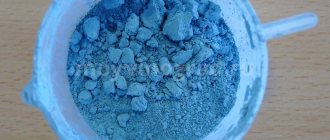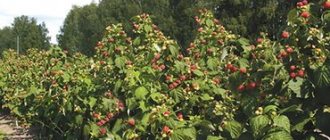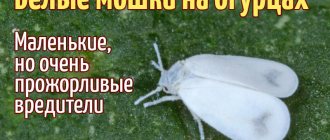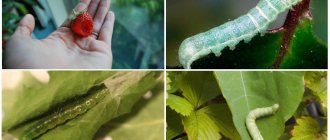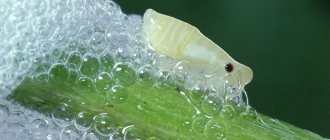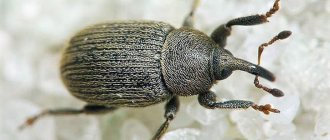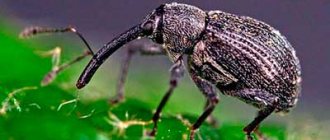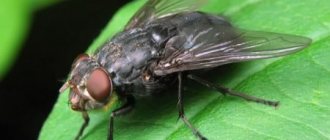Gardeners who grow strawberries know very well how capricious this crop can be. And in order to get a rich harvest of berries with healthy vitamins, you have to make a lot of effort. At the same time, pests cause a lot of trouble, because they also do not mind feasting on the life-giving nectar of plants and fruits.
One of the representatives of the genus of the most harmful insects is the whitefly. Outwardly, these insects resemble white midges. But miniature creatures seem harmless only at first glance; in fact, they pose a serious danger to garden crops.
If white midges appear on strawberries, you need to immediately start fighting them, otherwise the harvest will be lost. These midges cause the most damage to plants. After all, it all ends not only with a noticeable decrease in the yield. A pest attack can lead to the death of the crop.
You need to know the enemy by sight!
Before moving on to ways to combat this miniature pest, it is worth getting to know it better. In Latin, their name is as follows - Aleyrodidae. They belong to representatives of insects with incomplete transformation. However, these pests are characterized by complex development. The size of the whitefly is very small - the length of the body does not exceed 1 millimeter! But due to the fact that insects settle in colonies, they can easily be seen even with the naked eye.
The whitefly survives the winter in grass that has not been harvested since the fall, and with the advent of the first warm days, the insects awaken from a long hibernation and move to the shoots and leaves of plants. And strawberries are an ideal haven for whiteflies.
Attention! For the winter, it is imperative to remove all plant remains from the area, including diseased bushes. You also need to regularly weed and remove weeds.
Only the greatest harm is caused not by adults, but by larvae that live on the underside of strawberry leaves. Their favorite diet is the life-giving juice of garden crops and tender green pulp. For this reason, some time after they settle in, small holes can be noticed on the leaves.
If previously these insects attacked the plants of gardeners in the southern regions, now colonies of pests can settle in the territory of central Russia. The climate here is moderate, with occasional frosts.
The increase in the insect's range is largely determined by the improvement in its ability to hibernate. Some individuals can wait out the cold even in open areas!
White midges are clearly visible on strawberry leaves
Description of the pest
Whiteflies, Aleyrodidae in Latin, belong to a large family of homoptera insects. Damage to strawberry plantings is mainly caused by the strawberry whitefly - Aleurodes fragariae.
This insect is similar in appearance to a whitish miniature moth with thin wings and a yellowish body. The length of an adult reaches 1.2-1.8 mm. The wings have a mealy coating identical to that of moths.
It is not difficult to detect, so it is important to check strawberry leaves regularly. Particular attention is paid to the seamy side, where pests usually accumulate.
The insect is small, but the trouble is big
The danger of whiteflies lies not only in the devouring of strawberries by adults and larvae. Despite their simply huge and insatiable appetite, insects are not able to assimilate all the plant juice they consume, and therefore excrete a special waste product. Visually it looks like dew. And this is simply an ideal environment for the development of a dangerous fungus, which is popularly called mob.
This disease is no less dangerous for garden crops than whitefly. The fungus is able to completely clog the holes in the green part of the plant. This leads to the inevitable cessation of photosynthesis. As a result, the plant withers and dies within a short period of time.
Some gardeners are inclined to believe that flies are found only in open areas. In reality, this opinion is wrong, and whiteflies can be found even in greenhouses. Moreover, greenhouses are an ideal habitat for pests. After all, there is a high level of humidity and constant warmth - what else can you dream of?
Reasons for appearance on strawberries
A large number of whiteflies on strawberry bushes are observed during the period when hot summer weather sets in. Another factor that provokes the development of the pest is high humidity. When watering, avoid stagnation of water on the soil surface. Remove fallen leaves and do not use excessively dense mulching materials.
Small insects often accumulate in greenhouses. If they are heated, then even in the winter season these pests damage the plants. Thickened strawberry plantings are especially favorable for whiteflies. Excessive amounts of nitrogen fertilizers, which cause rapid growth of green mass, are dangerous.
See also: The best varieties and rules for planting strawberries in the Moscow region
Just don't give up!
Most experienced gardeners are aware of the danger posed by whiteflies, and therefore try with all their might to combat such a threat. Some use glue traps - a simple method, but not the most effective. The threat from insects is also related to the rate of egg laying. Over a short lifespan (no more than 30 days), the female is capable of laying up to 250 eggs, from which larvae mature within a week.
It will be interesting! The whitefly loves hot and humid conditions, but as soon as the temperature drops to +10 °C, the insects die.
In open ground, reproduction mainly occurs in the summer; in greenhouse conditions, this process can take place all year round. Therefore, a glue trap is not able to completely get rid of insects, and for each missed individual, several hundred new ones soon appear.
For this reason, it is worth using more effective methods:
- chemicals;
- biological agents;
- traditional methods.
The main thing is to give preference only to well-known manufacturers and follow the instructions that come with each drug. It is also worth taking precautions when working with chemical protective equipment.
It is worth considering one feature, due to which pest control should begin as early as possible. Chemicals can only affect adults, while the larvae have strong immunity to any drug.
Prevention of re-infection
To preserve strawberry plantings from possible whitefly damage, it is necessary to carry out simple preventive measures:
- do not allow strawberry bushes to be planted too densely;
- regularly inspect plants;
- carry out systematic ventilation in greenhouses;
- avoid high soil moisture;
- remove weeds in a timely manner;
- plant peppermint nearby, the aroma of which the whitefly does not like (you can also sow lemon balm).
- immediately after the snow melts, spray the plants with a decoction of these herbs every three weeks;
- cut out the dried stems and leaf blades of the strawberries.
The miniature whitefly is not capable of causing serious damage to strawberry plantings if effective control methods are used at the first sign of the appearance of these insects. They include chemicals, folk remedies, and biological methods.
Next
StrawberriesStrawberry diseases: description and methods of control
Chemistry help
Chemicals should be used when there are large numbers of pests or in cases where more gentle control methods no longer give the desired result. Just keep in mind that due to resistance to a number of drugs, not every type of insecticide is suitable for solving the problem.
Actellik, a contact action product (sprayer), has a good effect. The advantage of this drug is that its active substances do not penetrate into the plant and berries, so there is no danger to the crop itself.
Often they use drugs that have a detrimental effect on the digestive system of insects. To get rid of white midges, use the following means:
- Aktara - the drug is effective for destroying more than 100 varieties of garden pests.
- Rovikurt is an oily liquid against mass destruction of berry crops.
- Pegasus" and Condifor help get rid of the pest if it is detected early.
- Fitoverm, Vertimek are insectoacaricides that have a wide spectrum of action, and insects do not get used to them.
In order to increase the effectiveness of the fight against whitefly, it is worth further strengthening the immunity of plants and increasing their resistance. To do this, insecticide treatment should be combined with the use of a growth stimulator. The drug “Bud” has good qualities.
One of the most effective means of controlling whiteflies on strawberries is chemical treatment.
Why is it dangerous?
Since white midges feed on plant juices, it all ultimately comes down to the fact that the plants begin to die from lack of nutrients. In addition, large colonies of midges begin to fly to other neighboring plants and even trees.
As a result of the appearance of sticky dew, which has already been mentioned, the process of photosynthesis is disrupted. The leaves do not receive proper nutrition, spots appear on them, they begin to curl, and then completely wither. As a result of weakening, in addition to the whitefly itself, other insects can attack the bushes, but most often already weakened bushes begin to get sick under the influence of various fungal and other diseases. In addition, the whitefly itself carries various diseases.
Despite its very modest size, this pest can cause a lot of trouble to plants and future harvests.
But, knowing what the enemy looks like in person, you can very quickly identify and eliminate him.
Rules for processing plants
In order to ruthlessly destroy whiteflies on strawberries by using chemicals, you must adhere to certain rules:
- Strictly follow the dosage prescribed by the manufacturers in the instructions!
- Spraying the crop should be carried out only in dry and windless weather!
- Use different preparations each time so that insects cannot get used to them!
- The process of treating plants should be carried out in the early morning hours or in the evening at sunset! The sun's rays coming into contact with drops containing toxic substances can cause burns.
- With frequent and incorrect use of chemicals, their substances accumulate in the soil. Eating berries collected from cultivated areas is unsafe!
For your information! The pest leaves behind transparent tracks on the back of the leaves, which make it easy to detect. Whiteflies can also be seen upon careful inspection.
You can significantly reduce the population of adult whiteflies and their larvae in your garden in 4 procedures, taking a break of 5 days. Only with each subsequent treatment should the concentration of the drug be reduced. Only compliance with these conditions will allow you to completely get rid of pests and keep the delicacy safe for consumption.
A little about the whitefly
The whitefly literally sucks the life juices out of the strawberries.
Oddly enough, the spread of whiteflies is associated with global warming.
If previously this pest was well known only in the hottest southern regions of our country, then with the warming of the general climate, the insect has reached temperate latitudes. It has not only expanded its range, but also expanded its wintering capabilities. Now it overwinters both in open ground and on strawberries or perennial weeds.
Appearance
Externally, the whitefly looks like a tiny moth.
The appearance is unremarkable.
This is a small white-yellowish moth, no more than 1–2 mm in size.
In rare cases, individuals of 5 mm are found, but this is rather an exception to the rule. Whiteflies can easily be confused with moths . It is not easy to notice its appearance on strawberry leaves, since it is “based” exclusively on the back side of the leaf blade.
How does the pest reproduce?
Whitefly egg laying.
Pest reproduction occurs as follows:
- Females lay light gray eggs on the inner surface of the leaf, 10–20 eggs at a time. In total, the clutch can contain from 150 to 300 eggs.
- Over time, pale green larvae with three pairs of legs and antennae emerge from the clutch.
- They actively look for a feeding place, and having found it, they feed, gradually forming a “false cocoon” - the result of 3 molts.
- After a while, an adult insect of the usual color with a pair of whitish wings emerges from the cocoon.
Kinds
In addition to the strawberry whitefly, the omnivorous cabbage whitefly can also attack strawberries.
In just one season, the pest can breed several generations of offspring . Entomologists have identified more than one and a half thousand species of this insect. In our country, 3 of them are most famous:
- Strawberry whitefly is a pest of strawberry and strawberry crops.
- The honeysuckle whitefly is an insect that can often be seen on grape leaves. Causes great damage and can overwinter in open ground.
- Cabbage whitefly is, as the name suggests, the main enemy of cabbage. However, it can easily switch to other vegetable crops.
Features of biological protection
When we fight pests using chemicals, we have to be extremely careful! Inept handling of drugs leads to various consequences. Moreover, not only plants are at risk; the gardener himself is also at risk in a certain sense.
The use of biomaterial is a more gentle solution and an alternative to chemistry. The essence of the biological technique is to intentionally introduce other insects to the garden crop, which will be beneficial by eating whitefly larvae. At the same time, the plants themselves remain safe and sound. Among such saviors we can note the two most common enemies of whiteflies:
- predatory bug Macrolophus;
- parasite of the greenhouse whitefly Encarzia.
Having completed the “cleansing”, the saviors leave the “processing” zone and move to another place. To purchase such biological material, you should contact any large garden farm or laboratory.
The Macrolophus bug is considered a true whitefly killer
Where is it found?
The natural habitat of strawberry alerodid is forests, parks, squares and home gardens located in the forest-steppe zone of that part of the former Soviet Union, which today is considered and is European. The whitefly loves shade, so, theoretically, it can settle almost anywhere in the designated area. Scientists identify three foci of total spread of the pest:
- Lviv region (Ukraine);
- Kyiv region (Ukraine);
- Moscow region (Russia).
The whitefly is a heat-loving insect that, among other things, favors high humidity. Therefore, you should be afraid of their invasion when it is a hot summer with heavy rainfall, creating an optimal environment for the reproduction of the strawberry pest.
Folk technique
In addition to specialists, gardeners themselves have been creating their own recipes for pest control for many decades, passing on the knowledge to their children to keep the business alive. And as practice shows, most folk methods are in no way inferior to specialized means of protection in terms of effectiveness. Moreover, they are completely safe for plants and the human body.
Idea! Various lice shampoos or sprays with finpronil will serve as a useful addition to the main means of protection. The shampoo is diluted in water and the leaves are washed with the solution, and the soil around the crop is treated with a spray.
Also, the peculiarity of folk methods is that they help get rid of whiteflies in cases where it is not possible to use chemicals. Basically, all recipes are based on the use of familiar products - onions, garlic, lemon. In other words, there is always a choice:
- If there is a small colony of insects in a small planting, then it is enough to wash the leaves on both sides with warm water, and also loosen the soil near the plants.
- Garlic tincture can repel insects. 100 g of peeled garlic is poured into a liter of water, after which the solution is infused for 7 days. The resulting mixture is filtered and poured into a separate container with a tight lid. For treatment, 10 ml of solution is diluted in a liter of water, and the beds with strawberries are sprayed with it. Treatment is carried out once a week.
- A decoction of lemon peels also has good effectiveness. It’s easy to prepare – use 5 lemons per liter of water. Cook for 60 minutes, after which the solution cools and the leaves of the crop are sprayed with it.
- Laundry soap is an equally effective and fast-acting remedy. Not only plant leaves, but also stems are treated with a soap solution.
- A light bulb next to the plantings. Not a single little midge can resist this trick, which is used by many summer residents. A light bulb turns on next to the crop in the evenings, and its light attracts insects. If they fly close enough, the pests die from the burns they receive. True, this only works with adults.
Moderate planting of seedlings at an optimal distance will help prevent the appearance of pests on strawberry crops - they should not be planted too close to each other, as this will interfere with the natural ventilation of the plants.
If the weather outside is humid, it is better not to water the plants and refuse to spray them. Otherwise, you can create all the conditions for active reproduction of pests
How to protect
To protect strawberries from larvae:
- Combine annual digging of the soil with the selection of larvae.
- Plant beetle repellent plants between the rows.
- Pour a little dry mustard into each well.
- Plant green manure plants in the garden beds in the fall.
- Use chemicals for severe lesions.
The fight against cockchafers must be carried out methodically, using all possible methods. You should not assume that the absence of larvae last year will protect the crop for a long time, because new pests will not keep you waiting.
In addition to the beetleworm, strawberries are affected by other pests: weevils, aphids, strawberry mites, whiteflies, leaf beetles, and slugs.
Preventive actions
No wonder there is a popular wisdom: the best defense is an attack. Therefore, any lover of garden crops interested in growing strawberries and other berries needs to prepare in advance for the upcoming attack from natural profit lovers.
It is optimal to place onion or garlic plantings between the rows - they emit a pungent and unpleasant odor for insects, which will avoid this place. True aesthetes should take a closer look at marigolds and nasturtiums. Small parasites also cannot stand the smell of these flowers.
Important! Since the damage from the miniature pest is very great, it is necessary to carefully inspect the young bush before planting it for the presence of uninvited guests. The main reason for the mass death of plantings is the acquisition of an infected seedling/
A similar effect can be achieved by using wood ash. To repel pests, you should scatter it near the bushes. In addition, it is useful to give the culture a hot shower every month. The water is heated to 80 °C, and the plants are watered from a watering can.
